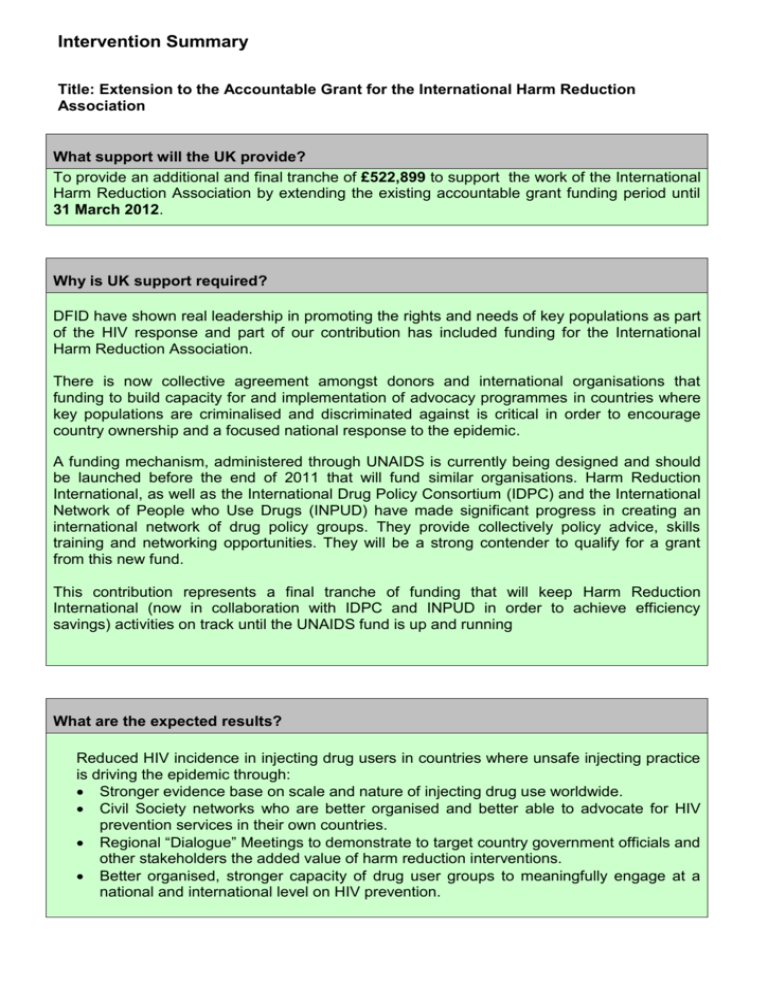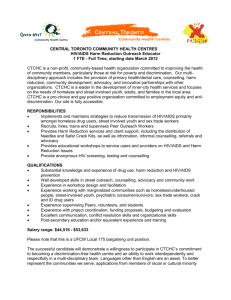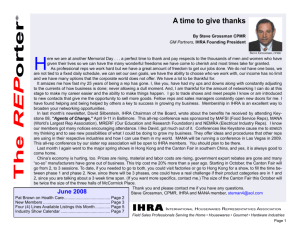Title: Extension to the Accountable Grant for the International Harm
advertisement

Intervention Summary Title: Extension to the Accountable Grant for the International Harm Reduction Association What support will the UK provide? To provide an additional and final tranche of £522,899 to support the work of the International Harm Reduction Association by extending the existing accountable grant funding period until 31 March 2012. Why is UK support required? DFID have shown real leadership in promoting the rights and needs of key populations as part of the HIV response and part of our contribution has included funding for the International Harm Reduction Association. There is now collective agreement amongst donors and international organisations that funding to build capacity for and implementation of advocacy programmes in countries where key populations are criminalised and discriminated against is critical in order to encourage country ownership and a focused national response to the epidemic. A funding mechanism, administered through UNAIDS is currently being designed and should be launched before the end of 2011 that will fund similar organisations. Harm Reduction International, as well as the International Drug Policy Consortium (IDPC) and the International Network of People who Use Drugs (INPUD) have made significant progress in creating an international network of drug policy groups. They provide collectively policy advice, skills training and networking opportunities. They will be a strong contender to qualify for a grant from this new fund. This contribution represents a final tranche of funding that will keep Harm Reduction International (now in collaboration with IDPC and INPUD in order to achieve efficiency savings) activities on track until the UNAIDS fund is up and running What are the expected results? Reduced HIV incidence in injecting drug users in countries where unsafe injecting practice is driving the epidemic through: Stronger evidence base on scale and nature of injecting drug use worldwide. Civil Society networks who are better organised and better able to advocate for HIV prevention services in their own countries. Regional “Dialogue” Meetings to demonstrate to target country government officials and other stakeholders the added value of harm reduction interventions. Better organised, stronger capacity of drug user groups to meaningfully engage at a national and international level on HIV prevention. Business Case for: Extension to the Accountable Grant for the International Harm Reduction Association. Strategic Case A. Context and need for DFID intervention A severe lack of funds for civil society advocacy and implementation remains a significant contributory factor to the paucity of HIV – related harm reduction services around the world. IHRA in the course of the current DFID grant have developed an international reputation as leaders in advocacy and research in harm reduction and drug policy. They have made significant efforts to broaden their donor base. The DFID contribution constitutes only 50% of their overall budget now as opposed to 90% when the grant started. Their work “The Global State of Harm Reduction” as well as a number of other publications are regularly quoted by international organisations such as WHO, UNAIDS and UNODC. IHRA have now developed working relationships with the International Drug Policy Consortium (IDPC) and the International Network of People who Use Drugs (INPUD) and have agreed that their skill sets are complementary and mutually reinforcing and have therefore produced a “consolidated bid” that would be administered through IHRA. The bid achieves efficiency savings and a more strategic approach to harm reduction advocacy internationally and is a strong contender for the new UNAIDS funding mechanism. This extension would allow the new alliance to establish itself as a single entity and position them to be able to submit a consolidated application to the new fund which is expected to be successful. B. Impact and Outcome The expected outcomes are: Stronger evidence base on scale and nature of injecting drug use worldwide. Civil Society networks who are better organised and better able to advocate for HIV prevention services in their own countries. Regional “Dialogue” Meetings to demonstrate to target country government officials and other stakeholders the added value of harm reduction interventions. Better organised, stronger capacity of drug user groups to meaningfully engage at a national and international level on HIV prevention. Reduced HIV incidence in injecting drug users in countries where unsafe injecting practice is driving the epidemic. As a result the acceptance, implementation, coverage and quality of harm reduction interventions should improve on a global scale bringing about a reduction in HIV transmission amongst injecting drug users and an improvement in human rights standards for some of the most vulnerable communities in the target countries. Appraisal Case A. Determining Critical Success Criteria (CSC) Each CSC is weighted 1 to 5, where 1 is least important and 5 is most important based on the relative importance of each criterion to the success of the intervention. CSC 1 Description Weighting (1-5) To provide and make accessible high quality and 5 innovative research and analysis necessary to inform national and international responses to HIV prevention in injecting drug users. Strengthened and increased capacity of civil society 5 organisations and drug user groups to engage effectively in national and international advocacy. 2 B. Feasible options In the table below: the quality of evidence for each option is rated as either Strong, Medium or Limited, the likely impact on climate change and environment is categorised as A, high potential risk / opportunity; B, medium / manageable potential risk / opportunity; C, low / no risk / opportunity; or D, core contribution to a multilateral organisation. Option Evidence rating 1 Not to provide any further funding to IRHA - Limited To provide one final tranche of C support to IRHA, extending the current accountable grant until 31 March 2012 - Strong 2 Climate change and category (A, B, C, D) C environment C. Appraisal of options Option 1 The capacity of IHRA and it’s partners will be seriously impaired, redundancies will be made risking the investment that DFID have already made in this organisation as well as that of other donors such as the EU and NL. Option 2 This is the preferred and recommended option. Key populations, including injecting drug users feature increasingly in the AIDS response. Needle and syringe exchange, and drug substitution therapy have long been recognised as cost-effective interventions1. A recent 1 Farrell M et al.1994 , Sorensen JL 2000 Lancet series states that these interventions should be supported on public health and human rights grounds2. However, only around 10% of people who use drugs worldwide are being reached, and far too many are imprisoned for minor offences or detained without trial. High rates of HIV transmission related to injecting drug use have also been found in prison settings. Political commitment and advocacy are needed to change this situation. Failure to do so will exacerbate the spread of HIV infection and undermine treatment programmes. IHRA, IDPC and INPUD provide the only credible HIV prevention with regards to international drug policy service and have developed a strong international reputation. Many of the countries that have concentrated epidemics are those that DFID following the BAR and the MAR will not be focussing bilateral funding towards as they are frequently Middle Income Countries. The work of IHRA and others will offer DFID the opportunity to continue to support these populations through our support to civil society, enabling them to develop their capacity to advocate for legislative and policy change. The funding mechanism for advocacy for key populations that UNAIDS is developing will hopefully be launched by the end of 2011. A number of governments including US, NL. Germany, Sweden, France and UK will be invited to contribute to one fund that will then distribute to those projects that meet the criteria of providing advocacy and capacity building to groups supporting at risk populations. The intention is that in future years IHRA and others will access their core funding from this. The extension to the DFID grant will allow them to continue with uninterrupted service until the mechanism is operational. D. Comparison of options Not applicable for an extension of an existing intervention. E. Measures to be used or developed to assess value for money In favour of Option 2. Value for money will be assessed in terms of the number of countries changing policies and ultimately the number of infections averted as a result of the policy change that is leveraged through this project. Harm reduction interventions are proven to be a cost-effective in preventing infections, with health benefits for individuals and wider communities. The impact of harm reduction is maximised when low-cost/high impact interventions are favoured over high cost/low impact interventions. This programme will develop greater evidence on what works in different country contexts and support advocacy and capacity building that will result in a more efficient allocation of resources and greater value for money across harm reduction efforts. The objective is to ensure policy change in countries where Injecting Drug Use is driving the HIV epidemic, thereby making it possible for those countries to politically and financially support their own programmes. Since most of the countries affected are middle income, this will ultimately relieve the burden on bi-lateral and multi-lateral donors. The independent evaluation of IRHA concluded 'DFID has received good value for money from IHRA during the programme and should now consider ways of capitalising on its 2 Beyrer, C et al.: Time to Act: A call for comprehensive HIV responses for people who use drugs. The Lancet, August 2010 investment by (a) promoting and enabling donor coordination for future IHRA funding, (b) supporting sustainability of future IHRA funding and/or (c) providing extra funding for activities not covered completely in the existing programme of work.' This extension takes on board these recommendations. Value for money will be one of the key criteria in the project completion report due in March 2012. Commercial Case Direct procurement A. Clearly state the procurement/commercial requirements for intervention Since this intervention involves contributing to the work of a UK based International NGO, the proposed funding model is to amend and extend the existing Accountable Grant. The funding will be provided directly to the International Harm Reduction Association, registered under this name at Companies House and The Charity Commission but now trading as Harm Reduction International. B. How does the intervention design use competition to drive commercial advantage for DFID? There is only one organisation which is suitable for covering this area of work, and it must be funded through an Accountable Grant, so this section is not relevant. C. How do we expect the market place will respond to this opportunity? Not applicable see above. D. What are the key underlying cost drivers? How is value added and how will we measure and improve this? Not applicable see above. E. What is the intended Procurement Process to support contract award? As for the above. As for the ongoing intervention each sub-contract to the regional networks will be awarded based on a written agreement between IHRA and the recipient. This will clearly specify the terms of the agreement including agreed activities and outputs, schedule of work, reporting requirements, payment schedule, legal basis of the contract, confidentiality, rights of both parties, dispute management, and financial accounting to DFID standards. F. How will contract & supplier performance be managed through the life of the intervention? Through standard project management procedures, ongoing monitoring and annual reporting. Quarterly financial statements as specified in the current Accountable Grant Agreement Letter and annual audited accounts of income will continue to be provided by IRHA. Indirect procurement A. Why is the proposed funding mechanism/form of arrangement the right one for this intervention, with this development partner? Not applicable see above. B. Value for money through procurement Not applicable see above. Financial Case A. How much it will cost The existing accountable grant will be increased by £522,899.00 to £2,753,151.00 terminating on 31 March 2012. 01/10/2011 to 31/03/2012 £s IRHA Personnel Operating and Support Projects Contribution to Partners INPUD IDPC Grand Total Research CSS CSA INPUD TOTALS (Dev) 32657 23640 67724 48301 17813 14576 49010 29803 7500 6500 0 0 6875 48000 178896 11250 11250 76000 38000 34000 0 129940 131563 82500 136468 71256 89800 105375 120000 522899 Budget £ 2006/7 2007/8 2008/9 2009/10 2010/11 2011/12 111722 209213 454237 459668 451617 464614 190903 + extension 522899 Total 11/12 713802 Total Grant 2,753,151 B. How it will be funded: capital/programme/admin Under programme funds allocated for the AIDS and Reproductive Health Team. C. How funds will be paid out An amendment letter will be issued and signed by both parties and funds will continue to be processed via the current accountable grant agreement. D. How expenditure will be monitored, reported, and accounted for Payment will be made against quarterly financial statements from the IRHA as specified in the current Accountable Grant Agreement Letter. IRHA will continue to provide annual audited accounts of income. Management Case A. Oversight The tasks of the Senior Policy Adviser, Research Analyst, Human Rights Advisor, and Communications and Project Development Officer at IHRA are set out in the original Logframe. The Administrator at IHRA will be responsible for project financial administration, administration of sub-contracts to partners including IDPC and INPUD, arranging travel and meetings, producing project documents, keeping project records, assisting with financial and administrative reporting to DFID, and recruitment and human resource issues. B. Management The project officer for DFID will continue to be Sally Chakawhata with Will Niblett as Quality Assurer and advisory input from the Harm Reduction and Corruption Adviser based at UNODC in Vienna and the Health and HIV Adviser for the AIDS and Reproductive Health Team. C. Conditionality None required. D. Monitoring and Evaluation Continued reporting as in the Logframe with quarterly meetings and annual reviews according to DFID corporate requirements. E. Risk Assessment None required. IHRA in the course of the current DFID grant have developed an international reputation as leaders in advocacy and research in harm reduction and drug policy as well as providing accurate and timely quarterly financial and annual audited statements. F. Results and Benefits Management The existing logframe for this project sets out results and benefits management criteria in the following areas. Multilateral organisations make explicit reference to, and commitments for, harm reduction interventions (and the human rights of drug users) in their policy documentation. Harm reduction funding from multilaterals (and other donors) increases and is proportionate to evidenced need, leading to increases in harm reduction resource allocation and service delivery. HIV Prevention initiatives for Injecting Drug Users are fully funded by either the government of the country in question or through multilateral organisations. Project Management arrangements are being revised to reflect the new collaborations with IDPC and INPUD as set out in this Business Case.



